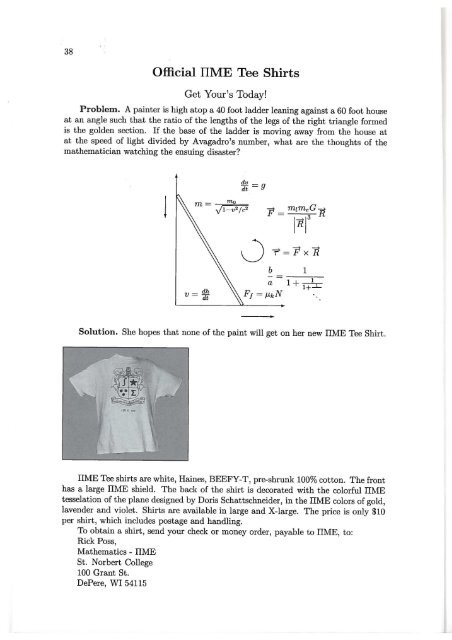You also want an ePaper? Increase the reach of your titles
YUMPU automatically turns print PDFs into web optimized ePapers that Google loves.
·'<br />
38<br />
Official IIME Tee Shirts<br />
Get Your's Today!<br />
Problem. A painter is high atop a 40 foot ladder leaning against a 60 foot house<br />
at an angle such that the ratio of the lengths of the legs of the right triangle formed<br />
is the golden section. If the base of the ladder is moving away from the house at<br />
at the speed of light divided by Avagadro's number, what are the thoughts of the<br />
mathematician watching the ensuing disaster?<br />
j<br />
v = dh<br />
dt<br />
dv _ g<br />
dt -<br />
F = mzmeGR<br />
<strong>11</strong>ll 3<br />
0 r> =FxR<br />
b 1<br />
= ----:---<br />
a 1+1+<strong>11</strong><br />
Ft = J.tkN<br />
Solution. She hopes that none of the paint will get on her new IIME Tee Shirt.<br />
TIME Journal, <strong>Vol</strong>. <strong>11</strong>, <strong>No</strong>. 1, pp 39-44, 1999. 39<br />
PARTITIONS AND YOUNG'S LATTICES<br />
DAVID WARREN*<br />
An earlier paper in this journal [2] explored the relationships between partitions<br />
and their Young lattices. The purpose of this article is to expand that work. We<br />
begin with a review of partitions, lattices, and Hasse diagrams.<br />
A partition of a natural number N is a finite sequence of natural numbers n1, n2,<br />
... , nm in non-increasing order such that l::i=l mni = N. We will represent partitions<br />
by Ferrer's diagrams as shown in the first example. See [1] for details.<br />
Example 1. Ferrer's diagram for the partition (4, 2, 1) of seven is shown in Figure<br />
1.<br />
FIG. 1.<br />
A lattice is a partially ordered set that has the property that any two elements<br />
x and y have a least upper bound (join) and a greatest lower bound (meet). If we<br />
order the set of all partitions of a set P by containment, the resulting poset is a lattice<br />
called Young's lattice. We will represent the resulting lattices as a Hasse diagram.<br />
The bottom element in a Hasse diagram is assigned a rank of one. The rank of<br />
a subpartition in Young's lattice is the number of squares in Ferrer's diagram of that<br />
partition.<br />
In [2] it was shown that Young's lattice for the partition (n) is a single chain as<br />
shown in Figure 2, and Young's lattice for the partition (n, 2) (with n > 2) is shown<br />
IIME Tee shirts are white, Haines, BEEFY-T, pre-shrunk 100% cotton. The front<br />
has a large IIME shield. The back of the shirt is decorated with the colorful IIME<br />
tesselation of the plane designed by Doris Schattschneider, in the IIME colors of gold,<br />
lavender and violet. Shirts are available in large and X-large. The price is only $10<br />
per shirt, which includes postage and handling.<br />
To obtain a shirt, send your check or money order, payable to IIME, to:<br />
Rick Poss,<br />
Mathematics- IIME<br />
St. <strong>No</strong>rbert College<br />
100 Grant St.<br />
DePere, WI 54<strong>11</strong>5<br />
FIG. 2.<br />
in Figure 3.<br />
*Hendrix College<br />
n<br />
D<br />
(1)
















